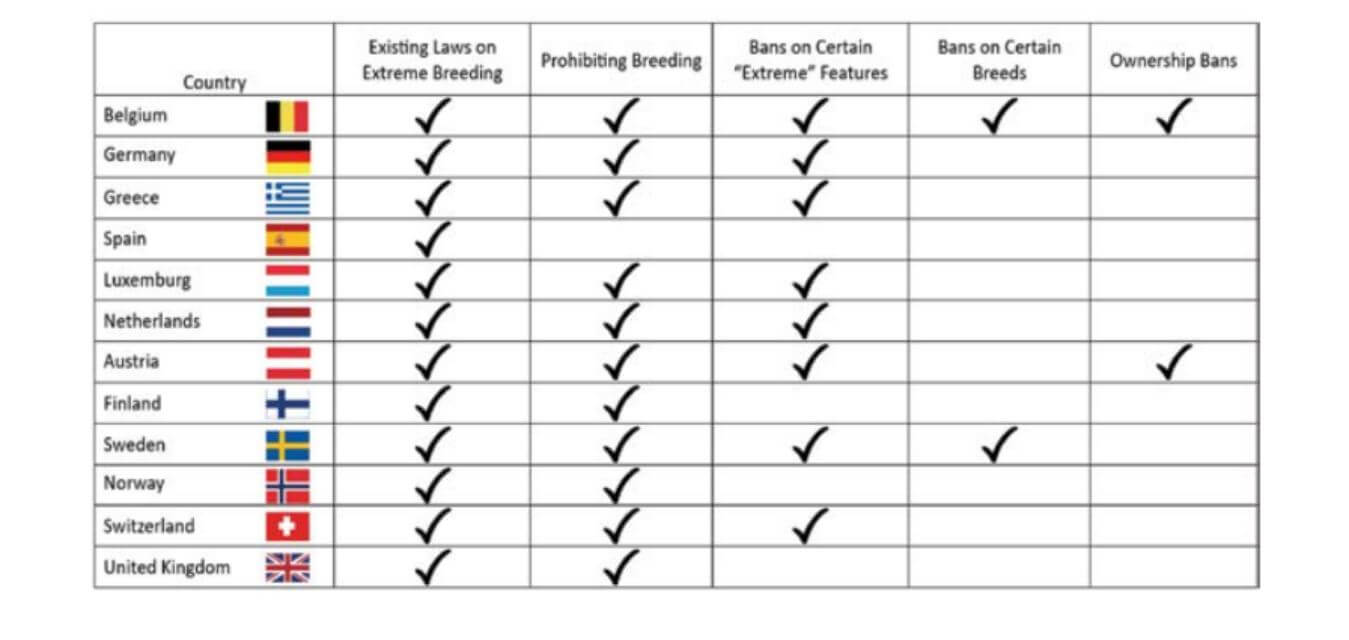
Home » Torture Breeding: The Dangerous New Threat to Our Breeds

For more than a generation, animal extremists have carried out a systematic campaign against purebred dogs and purebred dog breeding. In the last decade, their radical ideas have increasingly gained a stronger footing in Europe, reinforced with the passage of each new piece of legislation or law that restricts dog breeders and breeding.
Division and apathy among breeders and fanciers—along with a division of labor between the FCI (the show-giving authority) and national kennel clubs (which register dogs)—has contributed to weak resistance and the success of animal rights policy. Today, laws that ban or threaten the future of certain breeds are already firmly in place throughout Europe.
Historically, numerous social, political, or welfare movements that started in Europe have made their way to the United States. In the case of radical dog breeding laws, success in Europe seems to provide a cachet of legitimacy in other parts of the world, where little exists.
And now, proponents of radical qualzucht laws are turning their sights to the other side of the Atlantic.
Translated from German, qualzucht literally means “torture breeding.” It’s also often translated as “extreme breeding.” Torture breeding laws target certain breeds, or breeds with certain characteristics, claiming they are intrinsically unhealthy; and without demonstrated proof, seek to stop the breeding of particular breeds or dogs with those characteristics. In turn, they often promote the breeding of dogs of two different breeds as a cure-all.
In Germany, if pain, suffering, damage, or behavioral disorders are caused in the breeding of animals and can thus be traced back to the promotion of traits, this is considered qualzucht (“torture breeding”/ “extreme breeding”) and subject to cruelty laws. Disorders commonly cited as tortuous include: Chrondrodysplasia, hairlessness, merle, brachycephaly, “excessive” skin wrinkling, hip dysplasia, eye issues, deafness, and many others. In some instances, artificial insemination is also considered mutilation or cruelty.
A stark wake-up call for Americans came early this year in the form of New Hampshire House Bill 1102 (HB 1102). (See SHOWSIGHT, February 28, 2024, “Breed Type Under Attack.”) The bill was one of the most egregious anti-breeding bills introduced in a state legislature over the past decade, seeking to change state animal cruelty laws to describe brachycephaly as a “birth deformity that causes suffering”—and criminalize the sale and breeding of brachycephalic dogs and any dog that could be claimed to have a birth deformity.
Violators of the proposed legislation could be found guilty of a misdemeanor for a first offense, and of a class B felony for a second or subsequent offense.
Although the bill appeared to target brachycephalic breeds and was commonly called “the brachy bill” by fanciers, lawmakers, and the media, the implications were even worse than that. Expansive bill language targeted the breeding of all dogs, potentially including any characteristic that could arbitrarily be termed a “birth deformity.” The proposal did not define “birth deformity,” instead only referencing it as an example of a characteristic arbitrarily interpreted to “cause suffering.”
The New Hampshire bill was the first torture breeding bill to gain significant traction in the US, but it’s far from the first radical attempt to use specific health issues to ban the breeding of dogs based on genetics or perceived genetic traits. A 2023 bill in Illinois (HB 3200) would have required vague and unspecified “genetic testing for all dogs owned by dog breeders,” further requiring that if a genetic defect or mutation were found that could cause physical impairment or early death, the animal must be sterilized immediately. That bill never received a committee hearing. Similar but less specific health testing requirements have also been proposed for federal breeder licensing.
Policies banning the breeding or ownership of dogs with specific characteristics have been a fixture of canine legislation in Europe for more than a decade. Despite inadequately demonstrated claims about overall health problems in some breeds, they have already resulted in breeding bans.
In 2020, the Dutch Kennel Club, under existential threats from government entities and animal rights groups, limited the registration of certain brachycephalic breeds. In 2021, the Norwegian parliament passed a law making breeders legally liable for producing unhealthy dogs. That law became the basis for a 2022 court case that arbitrarily banned the breeding of all Bulldogs and Cavalier King Charles Spaniels in Norway. The ban on the breeding of Bulldogs was subsequently rescinded, but the ban on breeding Cavaliers remains.
Elsewhere in Europe, countries from Belgium to the United Kingdon have passed laws with arbitrary definitions of “extreme” breeding, and at least eight European countries have laws on the books that ban certain “extreme” features. (See chart below.)

Bans on breed characteristics play into the international animal rights/animal protection agenda that sees humans’ purposeful selection and breeding of dogs (and other animals) as enslavement or morally repugnant. Focused attacks on specific characteristics provide an incremental way to change government policies to limit dog breeding. False narratives of widespread cruelty, and the citing of truly extreme cases of unhealthy dogs that are outliers from the norm, build support among a soft-hearted but uninformed public, creating acceptance of arbitrary policies that lack a basis in science, data, or reality.
Of course, like humans, there are dogs that have health issues that may be congenital or genetic. Breed-based research provides a limited group or cohort for study that can highlight and help to resolve concerns for specific breeds in a way that simply can’t be done for mixes. It’s not that mixes are healthier; rather this type of specific research doesn’t exist for mixes. Responsible breeders support health research to learn more about concerns in their breeds and how to prevent them and/or breed away from them. But sadly, cases of individual dogs with issues that could be associated with their breed characteristics have been seized upon and presented by extremists not as outliers but as the norm.
Proposals gained ground quickly in Europe as numerous clubs, breeders, and animal welfare organizations failed to defend against attacks on breeders and agreed to legislative compromise with animal rights groups. Many believed that the policies would not impact them, that calls to fight against animal extremists were alarmist, or that compromise would make the issue go away. Instead, the opposite happened: Incremental success strengthened and
radicalized the movement; and today, some of the breeds or breed characteristics face potential extinction in Europe because of it.
In the US, the American Kennel Club and other allied organizations have faced animal rights battles straight on. Even so, too many US dog enthusiasts share the same outlook as their European counterparts a decade ago. Preserving our breeds and breed characteristics isn’t just a nice slogan, it’s a call to action. The term “preservation breeder” should not be used to divide breeders, it should be a rally by breeders against a very real threat.
The following are just a few of examples of what to expect with bills to ban breed characteristics.
Bills to ban or criminalize breed characteristics and their breeders are here to stay. New Hampshire HB 1102 failed, but only after a tough fight, with extensive ongoing efforts by a well-organized state federation (NH Dog Owners of the Granite State) working closely with AKC, industry groups, veterinarians, breed and local clubs, and concerned individuals.
These bills may appear at the state, federal, or local level. Proponents of the New Hampshire bill stated proudly that they would take the effort nationwide, and there’s no reason to doubt their resolve. We don’t know where bills to ban “extreme” breed characteristics will show up next, but we know they’re coming.
Bill proponents cite outliers and use false narratives to push for extreme solutions. As with any endeavor, outliers exist. In the case of dogs, this may be an unhealthy specimen or one with physical conformation that doesn’t meet the Breed Standard. Outliers by definition are not the norm, not to standard, and not what responsible breeders seek. Proposing an extreme solution impacting an entire population, based only on a few outliers, is neither appropriate nor responsible.
Skilled use of media and social platforms, along with outlier dogs. Proponents will find, if they can, a dog with a heart-breaking health issue to parade as its poster child for a specific problem, which they represent as standard. Specialist veterinarians who see a specific issue far more often that the average vet may be called in to describe their experiences. Consider the expression, “If the only tool you have is a hammer, everything looks like a nail.”
Attacks on Breed Standards. Proponents often call for “AKC to change the Breed Standard” for a breed. This belies a lack of knowledge about Breed Standards, which are not controlled by AKC but rather by their breed parent clubs. Parent clubs may be called upon, along with AKC, to explain and defend Breed Standards in a way that makes sense to people who have little or no knowledge of dogs, animal husbandry, or the nuances of language used in Standards.
Incrementalism/Divide and Conquer. Most anti-breed and anti-breeder groups pursue policies of incrementalism to achieve their goals. A bill that seeks to target only one characteristic (e.g., brachycephaly) is easier to get passed than one that targets many. Proponents often offer compromises if their initial effort isn’t going their way. Any win can provide a foothold for future incremental legislation. Similarly, when target groups are limited, (i.e., only brachycephaly) proponents know that enthusiasts of non-brachycephalic breeds will think they aren’t impacted or don’t need to engage. This is the foundation of a divide-and-conquer strategy targeting breeders, which was successful in Europe. It is crucial that all dog enthusiasts recognize that this is not just an attack on specific characteristics: It is an attack on all breeds and purposeful breeding. Apathy and “letting someone else deal with the issue” are among our biggest and most solvable threats.
Emotional Pleas. Emotion works! Humans learn through storytelling. Proponents of anti-breeding/anti-breeder policies will typically use a sad story and emotional arguments to advance policy, both in legislatures and with the media. Emotionalism may also extend to interactions with other actors. In some cases, personal attacks and bullying of those who oppose them may occur. If personal attacks or bullying happen, these and other unethical incidents should be brought to light immediately.
The foundations of this qualzucht attack on purebred dogs may seem exhausting to defend against and insurmountable. Yes, it may require a long and tiring effort, but defending against it certainly isn’t insurmountable.
Next month, the second part of this article will focus on what we can do to defend against torture breeding legislation, like promoting the multitude of benefits that come from our many breeds and demonstrating the assumptions and fallacies underlying extremist qualzucht proposals. We’ll talk about avoiding extreme breeding and perceptions of it, as well as the value of strong preparation and data. We’ll also share the experiences of AKC, DOGS, and allied groups in defending against the New Hampshire bill and the lessons we learned along the way, along with other strategies that can be used to stop similar legislation that seeks to change our beloved breeds as we know them.
